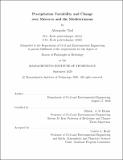Precipitation variability and change over Morocco and the Mediterranean
Author(s)
Tuel, Alexandre.
Download1227048910-MIT.pdf (48.22Mb)
Other Contributors
Massachusetts Institute of Technology. Department of Civil and Environmental Engineering.
Advisor
Elfatih. A. B. Eltahir.
Terms of use
Metadata
Show full item recordAbstract
Water is a critical factor limiting economic and social development in Morocco and the Mediterranean Basin. In addition to strong seasonality and high inter-annual variability, annual precipitation remains low (<500mm) across much of the region. Furthermore, the situation is not expected to improve under climate change as models project a sustained decline in precipitation in the Mediterranean, most pronounced during the winter season. Despite the significance of such projections, a comprehensive theory for Mediterranean winter climate change is still lacking. Here, we adopt a multi-faceted approach to investigate precipitation variability and change over Morocco and the Mediterranean, with a focus on resulting water availability. First, we link inter-annual variability of seasonal precipitation in Morocco to global sea-surface temperatures, and develop empirical forecast models that can predict up to 35% of this variability with a one-month lead time. Turning our attention to regional climate change processes and impacts, we show how future winter precipitation trends in the Mediterranean directly result from projected circulation anomalies. The enhanced advection of dry air from the Sahara Desert caused by these anomalies is key in causing precipitation to decline over Morocco. In addition, a major contribution of this work is to propose a physical explanation for the circulation trends involving planetary-scale circulation shifts and reduced warming of the Mediterranean Sea compared to land. We develop high-resolution regional climate simulations over Morocco to assess future risks from drought and weather extremes relevant to agriculture. Our results point to robust declines of 25-45% in annual precipitation and confirm physical drivers identified at the regional scale. Because snow is such an important component of the water cycle in this semi-arid region, we also investigate snowpack dynamics in the High Atlas and we quantify components of the snow water balance for the first time. Future trends in snowpack and associated runoff are also investigated: at best, snowpack volume will decline by at least 60%, which, combined with increased air dryness, will likely reduce mountain runoff by 60%. Our findings have important implications for climate change adaptation and water management in Morocco, particularly in agriculture, which uses 90% of all available water.
Description
Thesis: Ph. D. in Hydrology, Massachusetts Institute of Technology, Department of Civil and Environmental Engineering, September, 2020 Cataloged from student-submitted PDF of thesis. Includes bibliographical references (pages 264-287).
Date issued
2020Department
Massachusetts Institute of Technology. Department of Civil and Environmental EngineeringPublisher
Massachusetts Institute of Technology
Keywords
Civil and Environmental Engineering.